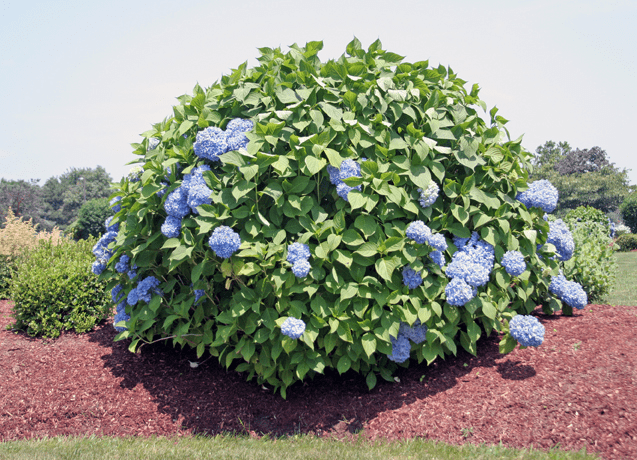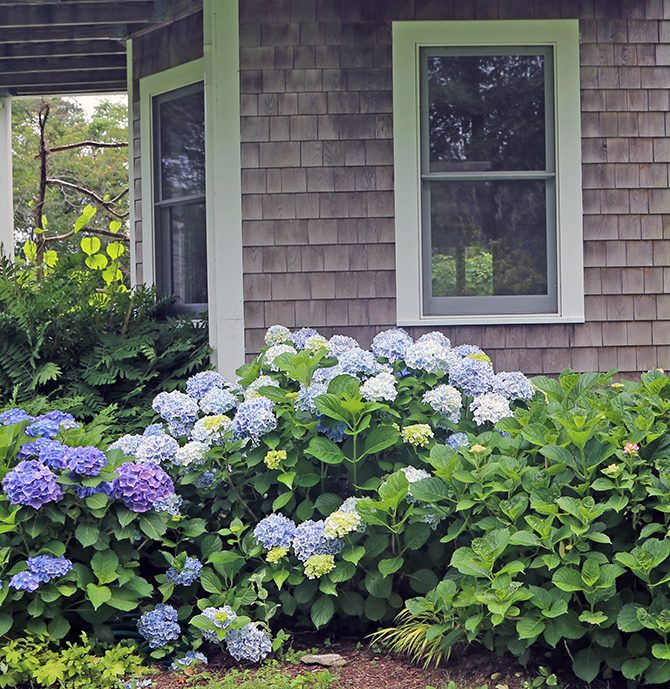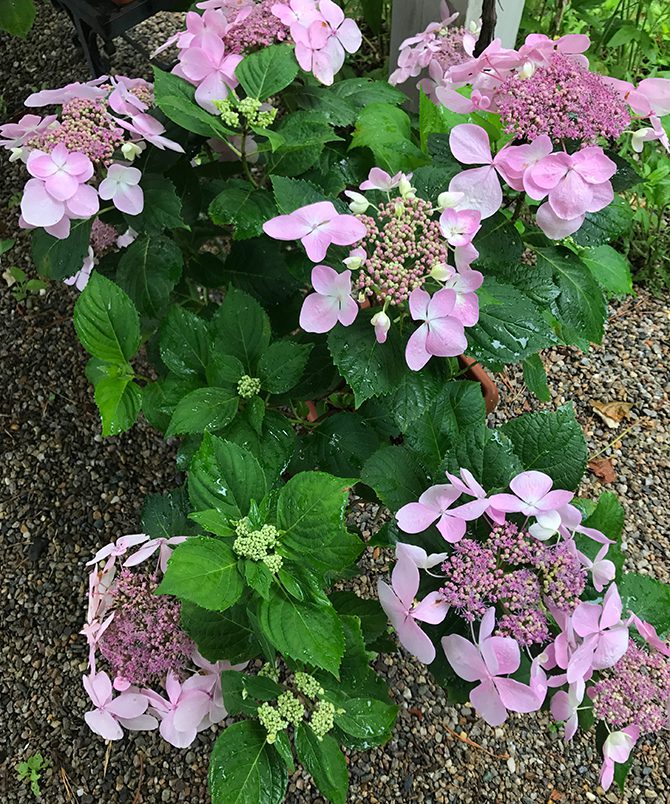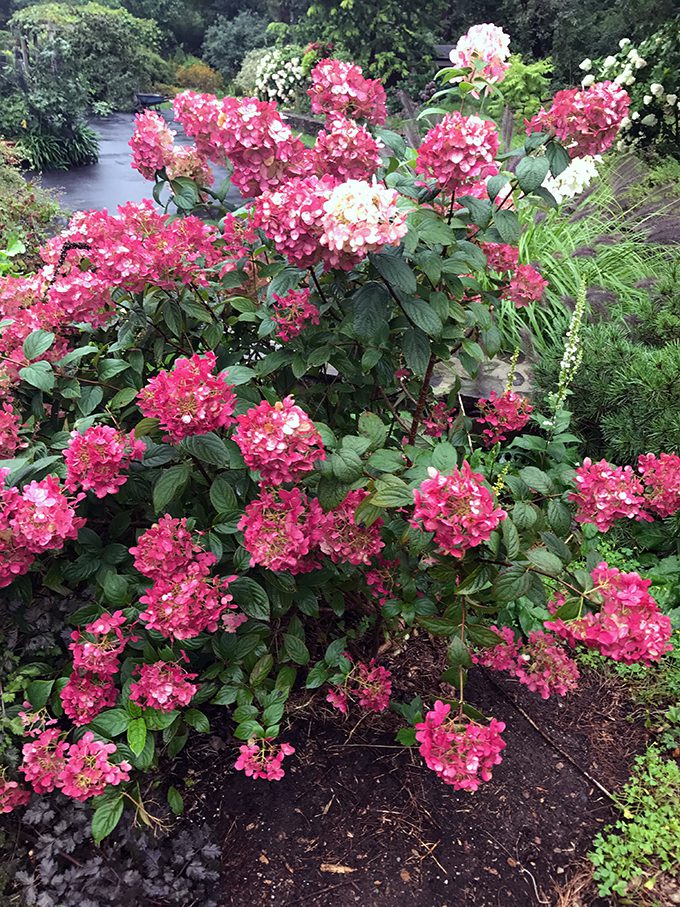“It’s Out of Control!” The Too Large Hydrangea
“It’s Out of Control!” The Too Large Hydrangea
Your hydrangea has gotten too big. It is growing up over the windows or spilling out into the walkway. Your hydrangea is covering nearby shrubs, or blocking the driveway. “How do I prune this to make it small again?” you ask.
The simple answer is that you don’t. Plants grow to be the size and shape that their genetics dictate, and trying to fight those genetics is foolish, especially if the plants have already gotten too tall. Additionally, the blue flowering mop head and lace cap hydrangeas that we Cape Codders love so much will not only replace and perhaps surpass their former height in one season, but will also have far fewer flowers if you cut them back. Here’s a photo to illustrate:

Here is a Nikko Blue Hydrangea that was clipped back by half in either the fall or spring. See how it is now, in July, a good six feet tall and eight feet in diameter once again? And notice how few flowers there are…and that there is a round dome of green leaves on top. This is the hallmark of a Hydrangea macrophylla that has been pruned to “get it under control” or to “clean it up.”
White flowering hydrangeas such as Annabelle or any of the Hydrangea paniculata, or panicle hydrangeas, flower on new growth so these will still flower well if they are cut back hard. But keep in mind this truism: pruning always stimulates growth. The more a shrub is pruned, the faster it will try and replace what it has lost.

This is a Hydrangea paniculata ‘Grandiflora’ – aka a peegee (or PG) hydrangea. The canes on this particular plant were cut down by half in the spring and when this photo was taken in late August those canes were just as long as they were the year before. And since those long canes were now new growth, the heavy flowers bent them to the ground whenever it rained. The fast growth that a hard pruning stimulates is weaker growth, and plants usually are more floppy the year or two after such pruning. In the past when this plant grew too tall and wide, homeowners pruned them from the bottom up, turning them into small trees. This is how the original “hydrangea trees” were formed…by cutting off the lower limbs where they joined the trunk to create what looks like a multi-stemmed small tree.
If your hydrangea is too wide for the location, you can dig it up and divide the plant, or move it back away from driveways and walks. If just a few stems are hanging into walkways, follow those to the ground or where they join another stem, and cut them off. The plant will produce new growth, but for a very short time you’ll have the passageways clear. If a hydrangea is up over the windows, move it to another location where it can grow as large as its genetics are dictating that it will be.
So how to keep a hydrangea under the windows, away from the walkway, or short enough to see over? Plant a short variety in that spot. Every year there are dozens of shorter growing hydrangeas being introduced. For example, most shrubs in the Seaside Serenade® series of Monrovia hydrangeas stay under 4 feet tall. (Country Garden has several in that series in stock now.) Other hydrangeas that stay shorter are the Cityline series, Let’s Dance Diva, H. paniculata Bobo, and Little Quickfire.

These Forever and Ever Hydrangeas are below the windows not because they were pruned, but because they only grow about four feet tall. No need to fight or to think that they are somehow misbehaving.

Let’s Dance Diva is a beautiful short hydrangea with HUGE lacecap flowers. Each of these blooms is the size of a dinner plate!

The hydrangea in the foreground is Cityline Rio. It only grows between two and three feet tall and a bit wider. And look at those rich, blue blooms! (Pinkish-purple plant to its right is Cityline Venice. The taller blue one behind Venice is Mathilda Gutges. The pink and purple behind that one are Forever and Ever Red and Forever and Ever Blue Heaven. The white to the left of the tree is a Hydrangea arborescens ‘Grandiflora.’

This is a short Hydrangea paniculata known for its dark pink flowers. This is Little Quickfire, a shrub that grows three to four feet tall and wide.
One of the challenges of being a home landscaper or gardener is admitting that we are not totally in charge, and that a plant isn’t “out of control” just because it’s gotten bigger. Maybe it was planted in the wrong location, or perhaps no one knew just how large it would ultimately grow. In any case, pruning it back to try and make it small again isn’t the answer. There are dozens of fantastic, shorter Hydrangeas available in all colors. Let us help you find one that won’t need any controlling at all.
Subscribe To Our Newsletter
Sign up for our weekly email about sales and events.
